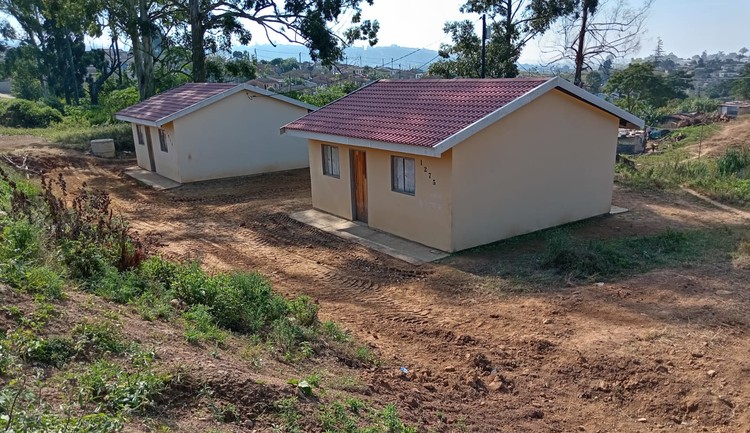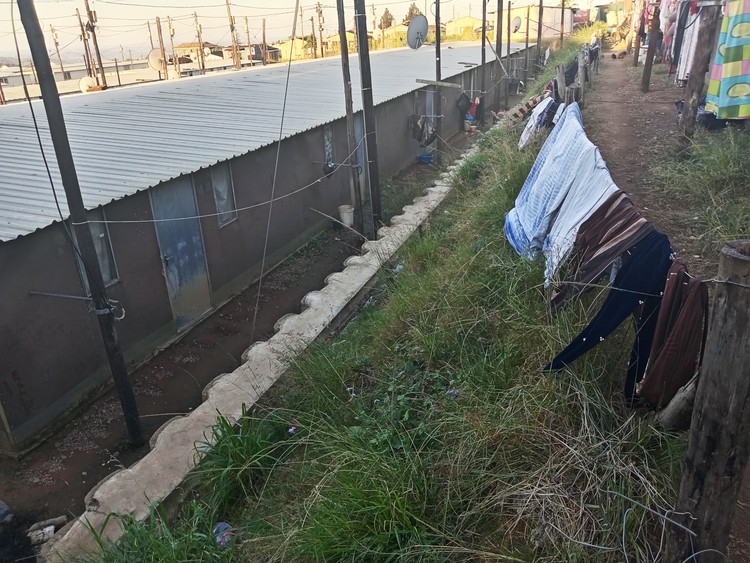After five years only 26 state houses built in Inanda
Families relocated to make way for housing project have been living in a poorly serviced transit camp
Two of the 26 houses completed at the Namibia Stop 8 housing project in Inanda, eThekwini. The 343-unit project was initiated in 2015. Photos: Tsoanelo Sefoloko.
- Only 26 of 343 state-subsidised houses have been built at the Namibia Stop 8 housing project, initiated in 2015.
- More than 80 households were moved off the land for the project in 2019.
- The transit camp has insufficient water and families have to share accommodation in pre-fabricated dormitories.
Having already waited for five years after being moved to a transit camp to make way for a housing project, residents of Inanda in eThekwini will have to wait even longer for their state-subsidised houses to be completed.
The Namibia Stop 8 housing project was initiated in 2015, and in November 2019 more than 80 households occupying the land were moved to a nearby transit camp to make way for 343 state-subsidised houses. So far, only 26 houses have been completed.
At the transit camp, where people who lost their homes during floods in April 2022 are also being accommodated, families are sharing accommodation in pre-fabricated buildings.
Water supply at the transit camp is intermittent. After a standpipe was vandalised in November 2022, water has been supplied by water trucks, which residents say is insufficient, with supplies not being replenished often enough.
Muzikayifani Zungu, who was moved to the transit camp last month, said he has found life at the site “unbearable”. He said the water trucks sometimes arrived once a week, sometimes twice a week. Zungu said there were no water storage facilities so everyone had to collect water from the truck with their own containers and store it as best they could.
Jabulile Mthalane, 68, who also arrived at the transit camp a month ago, said she was promised she would only have to be there for three months.
“I am hoping that they would provide me with my house because the life is not good here,” said Mthalane. She said the buildings in which they were housed were cold, and her husband was ill.
The transit camp to which people who were occupying land on which the Namibia Stop 8 housing project is being built have been moved.
When Groundup visited the Namibia Stop 8 housing project last year only one house had been completed, and contractors were still busy with roads and bulk infrastructure work.
Meanwhile, some beneficiaries who have moved into the few houses which have been completed, say they are dissatisfied as they are not allowed to extend their houses. They say at least the wattle-and-daub houses they used to live in accommodated their entire family and their furniture, but the new houses they’ve received are too small.
Beneficiary Nomthandazo Ngcobo said she was told she can’t add more rooms to her state-subsidised house even though there are not enough rooms to accommodate her family. Ngcobo said her wattle-and-daub house used to have six rooms; now she has to live within four rooms.
“I can afford to extend my [state-subsidised] house. Even before they moved us I was planning to renovate my [new] house,” she said.
However, Wendy Mkhize, who has yet to be relocated, said she was hoping to receive a house in the project despite it not being big enough to accommodate the nine people who currently lived with her in her wattle-and-daub house. Mkhize said the entire family was reliant on her wages of R2,800 per month, and she could not afford to build a proper house.
Ward 37 PR councillor Zamani Khuzwayo (DA) said he was shocked that only a few houses in the project have been completed since last year, adding it was clear the completion deadline of 15 December would not be met.
“Last year at the council meeting on 31 May they asked for additional funding of R43-million, and it was approved. We extended the deadline to December 2024. It seems as if they won’t meet the target time as it seems as if they only build two houses per month,” said Khuzwayo.
eThekwini Municipality spokesperson Gugu Sisilana said Stedone was the contractor appointed for both engineering services and top structures, with an initial budget of R100-million. The project had moved slowly because of the difficulty of relocating people to clear space for service infrastructure.
She said an additional R50-million had been requested for the project, with an 18-month extension to the completion deadline, which was now set for end December this year.
The approved layout plan has 343 residential sites ( 291 free standing houses and 52 double storey semi-detached houses), two worship sites, one community facility and one school site.
Support independent journalism
Donate using Payfast

Don't miss out on the latest news
We respect your privacy, and promise we won't spam you.
Next: People in Kariega queue for hours to collect water after devastating storm
Previous: In photos: Cape Town houses flooded
© 2024 GroundUp. This article is licensed under a Creative Commons Attribution-NoDerivatives 4.0 International License.
You may republish this article, so long as you credit the authors and GroundUp, and do not change the text. Please include a link back to the original article.
We put an invisible pixel in the article so that we can count traffic to republishers. All analytics tools are solely on our servers. We do not give our logs to any third party. Logs are deleted after two weeks. We do not use any IP address identifying information except to count regional traffic. We are solely interested in counting hits, not tracking users. If you republish, please do not delete the invisible pixel.


